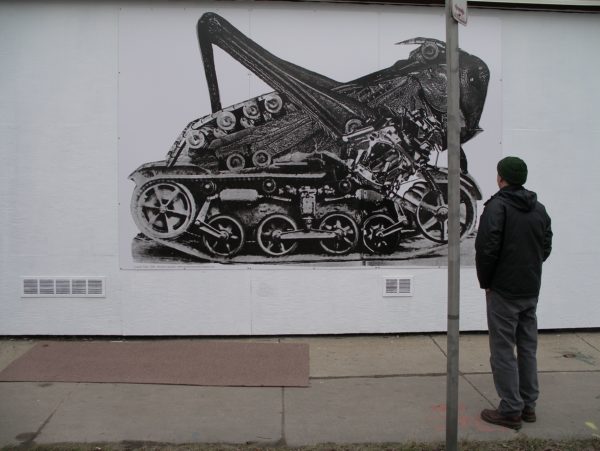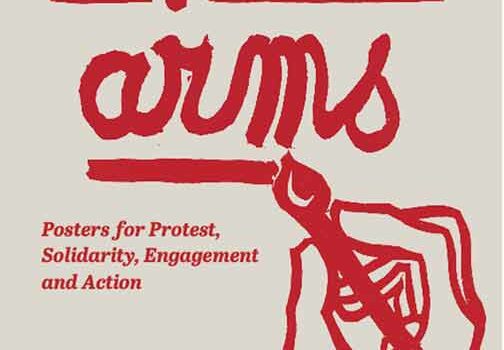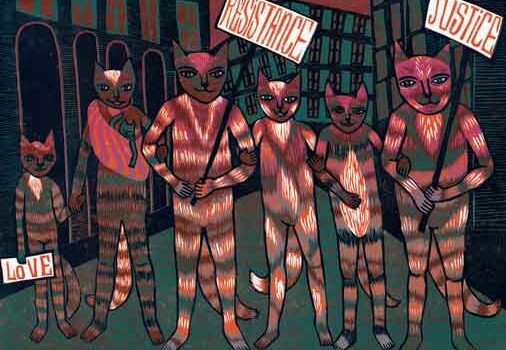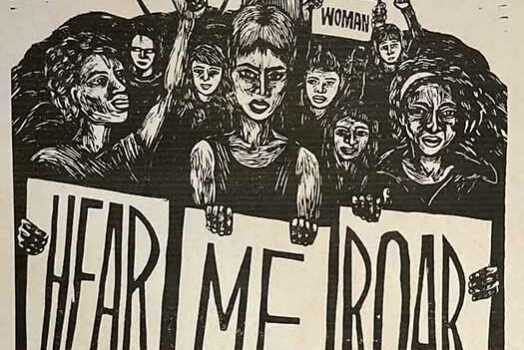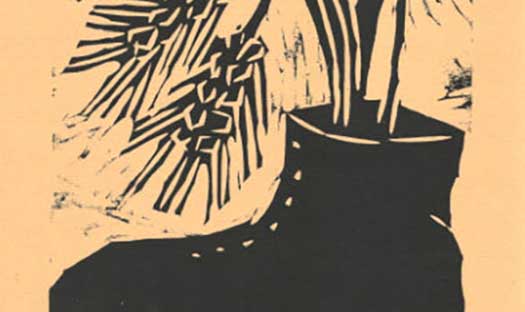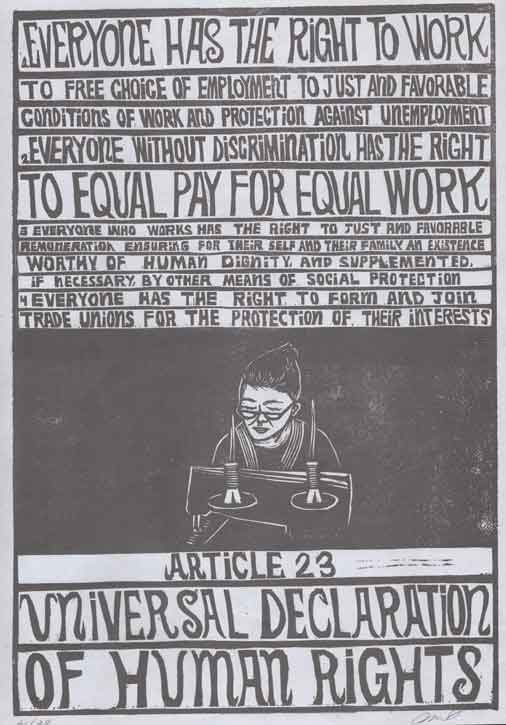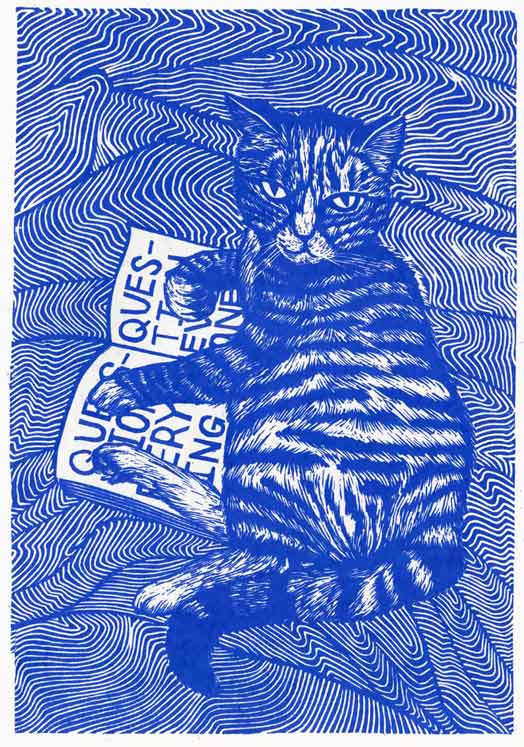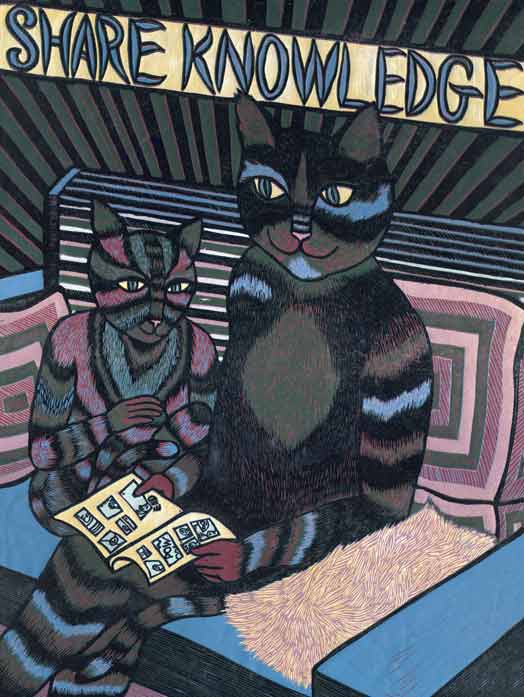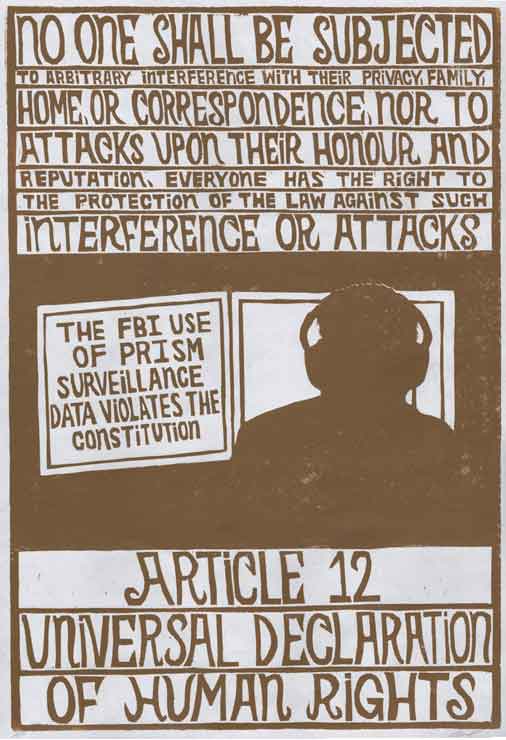Hey folks! I am enclosing an interview I conducted with Nicolas Lampert on a porch in the summer time in Milwaukee in 2004. The entire interview is enclosed below. Enjoy!
Nicolas Lampert – 2004 interview
For starters, what mediums do you work with and how did you become involved in them?
Since the early 1990’s my primary medium has been collage. I wanted to work with a medium that was immediate, something that could be created quickly and disseminated easily. I’ve been inspired by the work of John Heartfield and enjoy the graphic and photographic quality of collage art. Heartfield and a number of other artists influenced my individual practice, but a lot of what I’ve been doing recently is curating shows and setting up structures to allow other people to participate. Drawing Resistance, a traveling political art show that I co-organized with Sue Siminsky Bietila is one example of this type of structure. Overall, I have been more interested in working on these types of projects, instead of simply focusing on my own individual art.

What other artists and political movements influenced your work?
That’s a tough question because I find so many movements to be interesting. Lately, I have been drawn to the Mexican muralist movement and the 1930’s – the era of the WPA-FAP federally funded art programs. I’ve been particularly interested in the American Artists’ Congress where 400 artists gathered together in New York City in 1936 and set an agenda of speeches and essays about their concerns about the rise of fascism and war. It was an incredibly interesting time period. One aspect of their work was organizing a print show called America Today where 100 artists were selected and asked to pull a large edition of a single image so that duplicate exhibitions could be held throughout the US. In December of 1936, America Today opened in 30 cities. The prints themselves were not all that interesting, but the concept of the show was amazing, and I just thought that was such an incredible moment in art history. Yet, it’s something very few art history books talk about.
In terms of starting as an artist, where did your inspiration come from?
Like most artists, I imagine that I draw upon from my life experiences and my education – which can be a double-edged sword. I went to the University of Michigan and at the time, it was a very traditional art school that focused more on technique, rather than content. As an undergraduate, I was never exposed to political art and it wasn’t until I moved to the San Francisco Bay area that I became exposed to radical art. That changed everything for me. I got involved with Food not Bombs and volunteered at Free Radio Berkeley, a pirate radio station that set the standard for a lot of other stations throughout the country. I was young, in my mid twenties, and I threw myself into all these different movements. Tried to attend every protest march and meeting that I could. Eventually, it made sense to me that my art should be reflecting these concerns, so I started to use my art as a form of activism. Instead of going to all these meetings, I thought my time and my contribution to various struggles was much better served if I focused on radical art, something that utilized my particular skill set.
Were you making pieces linked to specific organizations?
I was more responding to issues and the political climate, both locally and internationally. I made a few graphics for organizations, but I have never been comfortable in being an illustrator, an artist where a group would see my work and say, “design of a poster of this.” Instead, I would create a lot of work and then put it out there in different ways – though art shows, wheat-pasting, sending images to radical magazines. If someone wanted to use my image, that was great, but I never went to a group and said, “I am an artist, how can I help.” I find that a difficult way to work because it stifles my own creative impulse for making the work in the first place.
Where have you shown your work?
I have shown my art in a variety of different ways from wheat-pasting, posting the work on-line, and putting it in art shows. Each one has a different life of its own.
Who is your target audience?
It’s hard to gage since images travel all over the place. I created a website of my collage art and licensed it under Creative Commons, which allows people to utilize the image if they credit it and do not use it for a commercial purpose. So it finds its way to numerous places. I got an email a while back from a person in Germany telling me that they took a number of images off my website and projected them at a massive rally in Berlin on the side of a building. They wrote me after the fact, and I had no control over it, but I thought it was fantastic. I think it’s always important to show, important to get the work out there, because art is at its core is communication. What good is it if your work sits at home or is seen by a limited amount of people in a gallery? But to answer your question, my audience is the general population. I think it’s more interesting to make art for anyone and everyone. Overall, I think artists tend to make the mistake of showing to a limited audience. When you go to a gallery, the gallery is predominately a place visited by other artists or artist enthusiasts. It serves a purpose, but I’m more interested in having a large cross section of the public see my work and in that regard, street art is by far the most accessible form of disseminating art. Wheat-pasting on a busy street corner is a kin to showing to the whole city and that to me is the more gratifying than the gallery space.
What has been the focus or content of your pieces?
I try to focus on larger more systemic issues. Rarely ever will I create work referencing a politician or a specific event. Instead the work is often about the environment, the impact of industrialization, globalization, genetic engineering – those types of topics. In a lot of the work, I try to leave it open enough so that it allows people to come to their own conclusion. I am aware of how to make very didactic art and do at times, but the majority of images are left more open, while still addressing social and political issues.
What do you hope to convey through your pieces?
I hope that a dialogue is created, and people are inspired to think critically and react to the work.
So what roles do you think art has in transforming and shaping society?
That is a difficult question. The reason why is that it tends to put art and the artists on a pedestal where artists are given a heightened sense of importance in society. It creates this idea that the artist has a leadership role in articulating a society. I think it’s a double-edged sword, because art is very important and culture does help shape the world, but the work of artists is just one of many facets of the human imagination.
Looking at historical references, especially since you are teaching classes on that, do you see historical examples of how art has played a role in shaping a movement or helping demonstrate the kinds of societies people are looking for? What are the dangers and positive potentials to transform society through art?
Well, my first reaction is to look at the Mexican muralist movement for it was a rare example where artists were given a stage where they could exert tremendous influence upon public opinion. In essence, the murals by Rivera, Siqueiros, Orozco, and others visualized the past and served as an education tool for the population, yet they were also steeped in nationalism. At their core, the murals served the primary interests of the government and even the images that honored indigenous cultures can be viewed as problematic. For starters, why was Rivera painting the images of indigenous cultures? Wouldn’t it been more ideal and democratic for indigenous people to represent their own culture and to decide if they indeed wanted their history on the side of building representing state power. Many scholars have argued that the murals as a whole attempted to convey the idea that Mexico was unified, that all of the people within its borders, both indigenous and non-indigenous were one and the murals were meant to celebrate a break from the past to the modernization of the county. Seen in this light, the murals can be read as government propaganda, and the muralists as hired hands who used the government as much as they used them. Of course, today the murals also serve the interests of the government and commerce as a destination places for tourists. This perhaps is too cynical reading of the work, but it goes into what I was saying about the abuses and the power of visual communication. The same can be said about John Heartfield’s work. He was a brilliant collage artist who deserves a lot of respect for taking on the Nazi regime and waging a graphic campaign against Hitler, but at the same time, his politics were skewed. Heartfield was a lifelong Communist whose art and vision was first and foremost dedicated to party politics. In that regard, how is that being critical of power? To sum it up, I’m very leery of individual artists having too much or too little power.
How do you define radical art?
I would define it as the communication of radical politics and potentials expressed through the arts.
So how would you describe the radical politics and possibilities?
I think it is specific to each struggle, but to generalize I would say that it is standing up and saying that you don’t accept things the way that they are.
So how do you gauge your own effectiveness in what you try to do, as a teacher, as a person organizing the Drawing Resistance show, and also as an individual artist?
That is another difficult question. I gauge my work by getting it out there, getting feedback from my peers, those whose work I admire. I think you can tell to a certain extent if your work is effective. You can tell by how receptive people are. I tend to work on a number of projects, all at the same time, and then focus on the ones that have the most momentum. What I’ve picked up on during the last decade of doing this type of work is that people tend to respond to the positive projects, the work that has a lot of hope and a positive message. Those are the works that people tend to gravitate towards the most. I think the Left is very reactionary and we tend to speak in negatives, like stop the war, stop the polluters, etc. and I think these things are important. But when the work tends to only be reinforcing all the negatives in the world, it drives people away. I think people end up becoming overwhelmed by the negatives in the world, and when you throw out more solutions, your audience tends to grow and the enthusiasm behind the project grows.
What is your utopian vision of a changed world?
I am inspired by the idea of self-sufficient communities taking root all over the world. Ideally, I’d like to see a world where local politics came first and each individual community had the power to make their own decisions. Power is a ubiquitous word because ideally this structure would be to limit power and the abuses of power. Obviously this type of structure would have to have some kinds of checks and balances and would rely upon mutual cooperation to address global issue, particularly the environment. At its core, it is about encouraging people to actively partake in democracy instead of signing off these responsibilities to others.
What do you see as the role of artists in the world in a utopian context?
As far as art as transformation, I think art works on multiple levels. The process of making art has a lot to do with transforming the individual. The act of creating art is very therapeutic. A lot of artists create work to understand themselves and make sense of the world we live in. The act is very positive. Yet, art can also be used as a vital means to get messages out, to challenge power and to inspire people to remain active or to get involved. That said, I think art should be completely free and up to the individual. I would never say that all art should be political. I think what makes art interesting is that there is this wide spectrum. I think abstract art, conceptual art and representational art is just as important as work that is overtly political. So as far as transforming society, I think art is just one facet out of many.
Do you think the state should sponsor art financially?
I am incredibly torn about that. Dependence on State institutions is a dead end road that is subject to politics and power, but as long as we live in a society dominated by governments, my inkling is that this money should be put towards the social good of a community. Obviously, tax money supports a massive police and military State and subsidizes the growth and protection of huge corporations. I would ideally want this money to instead fund free public healthcare, free education and to fund the arts – under terms that are determined by artists. This idea counters the notion of self-sufficient communities, so this should be seen as a temporary bridge, a transition towards community control over State control.

In terms of the Drawing Resistance, have you pursued grants?
Drawing Resistance is a unique situation. I wouldn’t belittle any artist or artist group for seeking out funding, but Drawing Resistance works in a completely different manner. We haven’t looked for funding because we set up a structure that is meant to allow it to function without much money. The show relies on a collective effort and it has traveled for three years on almost no budget. Any community that hosts the show simply needs to transport the show down the road to the next city. So we haven’t had the need for a lot of money because the costs have been low and they have been shared. Also, money has been raised by donations at each opening which helps cover the gas expense to transport the work. Ideally it might be nice to have some money to draw from, but if the show can travel for almost no funding, it could be an inspiration for other groups to do the same. It could demonstrate that you don’t have to rely on funding.
Was that a conscious choice that was made? To create a project that reflected a certain ideology?
Yes and no. The show does critique the idea of art as commodity and shares much in common with other D.I.Y projects. Instead of music going on tour, it was art going on tour. For Drawing Resistance, I organized the show with Sue Simensky Bietila and neither of us had organized anything like this before. There were no previous models of tours like this that we knew of, so it’s been a learning experience. We also had never applied for grants before, so we didn’t know how that system works. Personally, I am a little leery, because every time you ask for money you owe a little bit to the place you got it from, even if it’s from a very good cause. I think the fact that we are free of all sponsorship means we are free to make all our own decisions.
What do you think we should or could do if we outgrow our current support networks, if that makes sense? Josh MacPhee talks about how he is at the highest point of what he can do without drastically changing things; like he couldn’t make ten times the amount of posters he makes without changing his distribution structure fundamentally.
To me it’s more about recognizing who your audience is and making sure new people get introduced. So I’m not too worried about feeling that you have to change things too much. The support networks are there, they just need to be continually nurtured, which takes a lot of work.
So in terms of collaborative structures you are a part of how does leadership and decision making function?
Most of the collaborative projects that I have done to date are with one other person. It’s just a give and take relationship where it all depends on the relationship. Sometimes it’s smooth and sometimes not. I think the benefits of working with others totally outweigh the difficulties. I think artistic practice in general is far too much based on the individual, so I think it is inspiring to see the amount of art collectives that are popping up. What we are seeing now is that artists have a hard time making a living and there is no support for the arts, so we have to rely on each other to create projects.
Who do you think artists should be accountable to? Especially if we are a part of a community process?
I think artists have to be accountable to themselves. If you believe in the work you should be able to defend the content and the reasons for making it.
Can you can give a history of Drawing Resistance, what it is, how it came to be.
Well, Sue used to live in Milwaukee and we’d collaborated on prints before. We had been a part of a radical art community for a number of years; she had grown up on the east coast and knew a number of New York City artists and we both knew a lot of artists in Chicago and the Midwest. I had lived on the West Coast and had been a part of that community. So we had strong ties to a community of artists that we knew and decided that we should put on a show gathering art from about thirty artists. We first envisioned doing a single show but questioned the reasons behind showing in just one city. Part of the limited vision of political art in the US is that it tends to thrive in New York City, Chicago and San Francisco. People tend to recycle the same artwork and thinking. So we decided to put the show on the road and have it travel to many smaller cities that don’t regularly see this type of art. To us, the potential for creating a larger and more vital community happens when you get out of those three main cities. Same thing with bands going out on tour where playing in the smaller cities can be the most exciting. So we decided to follow that model. The show first started in Milwaukee. It opened four days before September 11th. We had gathered work in 2000 and much of the work was inspired by the energy of the anti-globalization movement, the protests in Seattle and Prague. We had no idea what was going to happen with the show. First we found hosts in Chicago, and once they organized their show, it belonged to a whole group of people and Sue and I took a back seat. That’s when the show gained its own inertia and became something larger. The reason why I think the show works and has traveled for so long is that we set up a structure where the hosts can have autonomy to make the show their own. When a host contacts us, we tell them that it is up to them to find a venue within their community and then can add a local show to accompany the traveling one and frame the show around their interests and the communities interests. Now that it has traveled for over three years, we have been able to reflect back on some of its successes and failures. To date, a lot of hosts have shown the work in an activist community, which I think tends to make the show more celebratory. I think that is important, but I am more intrigued when the host puts the show in a place that reaches the general public. That has happened in several cities. For instance, in Ann Arbor, Michigan, the host put it in the student union at the University of Michigan. I would imagine that a couple of thousand people saw the show due to its location. That month, I was getting upwards of twenty very negative hate mails a day but I thought it was wonderful because it meant the show was communicating to a new audience outside of the small community of activists and artists. One problem is that nothing in the show is for sale, and the hosts tend to put things in activist spaces because of that reason. From time to time it ends up in museums or libraries and so forth. In bigger cities Drawing Resistance tends to be just another show. In smaller cities it is often much bigger. One example that floored Sue and I was the opening in Winnipeg that had close to 700 people in attendance. We were not able to attend but the hosts sent us a picture of the building where the opening was and the entire street was lined with bicycles. To me, that affirmed that there is a large potential audience for activist art and people are hungry for it.
Are there changes you would make with the show at this point?
We eventually want to route the show back to Wisconsin, which may take a couple more years. As far as duplication, or what happens later, is unknown. I like projects that allow large groups of people to participate. This show had the same 30 people showing work in every city, but each city had local art shows accompanying it, and the process of so many people hosting the city has meant that hundreds of people have worked on the project. The show had its limitations because it was framed work, so that made it unfeasible to mail it. So driving was essential, and that put a lot of burden on the hosts. But it also made it so that the show could slowly move throughout various regions of the US and Canada and that made stronger connections. The framed element has also kept the work in North America. We had potentials to show in India and Europe, but it is prohibitively expensive to mail all the framed work. Our first outward mission was to create stronger networks in the radical art scene. There are a lot of artists working in this medium but they aren’t all connected. In that way it has completely succeeded. As far as other aspects, I think it has proven to me that there is a collective willingness in the United States. When we first launched the show we had no idea if people would help out because our society is so based upon the individual. My optimism is now much higher. That said, we still have had an incredibly hard time booking new shows, so a lot of more work needs to be done. What isolates us is that we don’t know about incredible stuff happening in cities five hours away from us. So to me, the show is about building networks, where the art serves as the introduction and not the conclusion.
